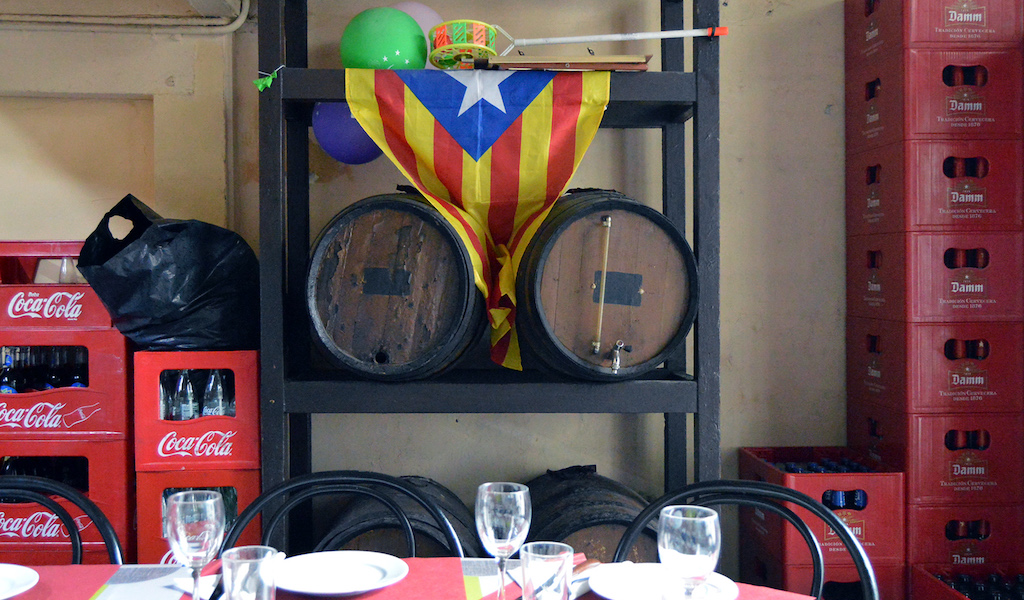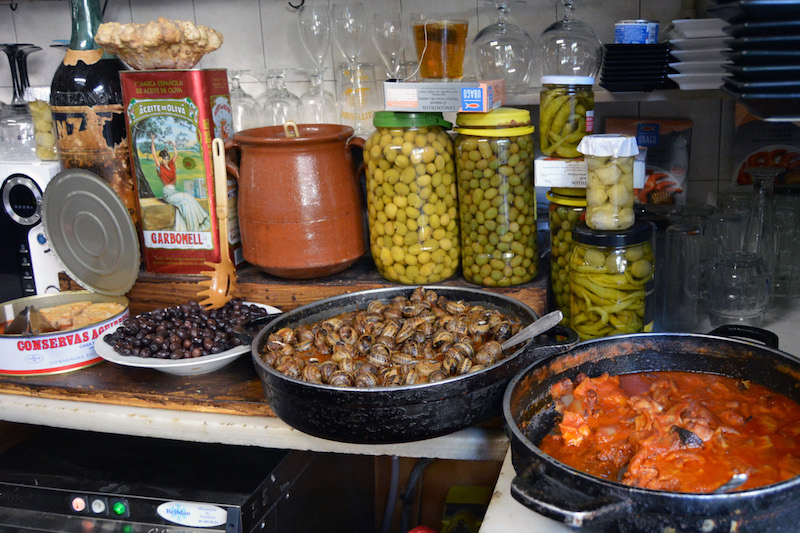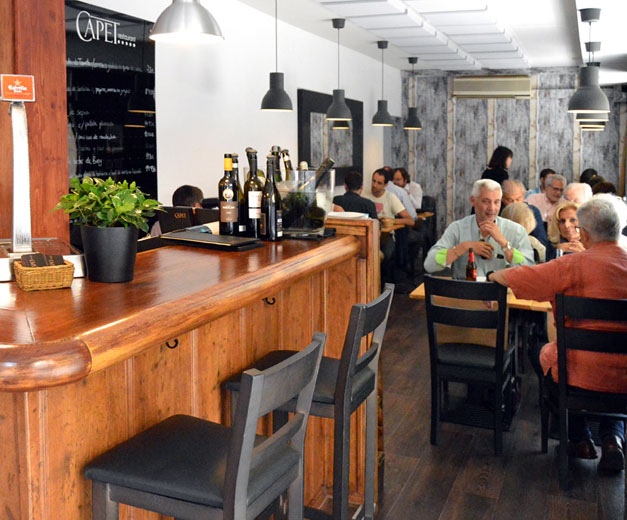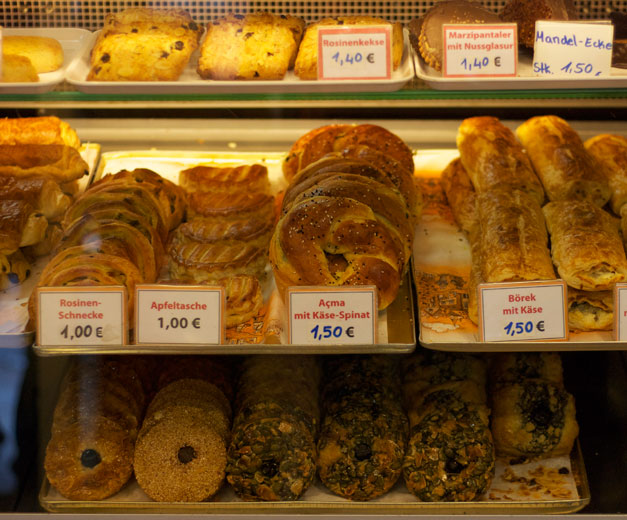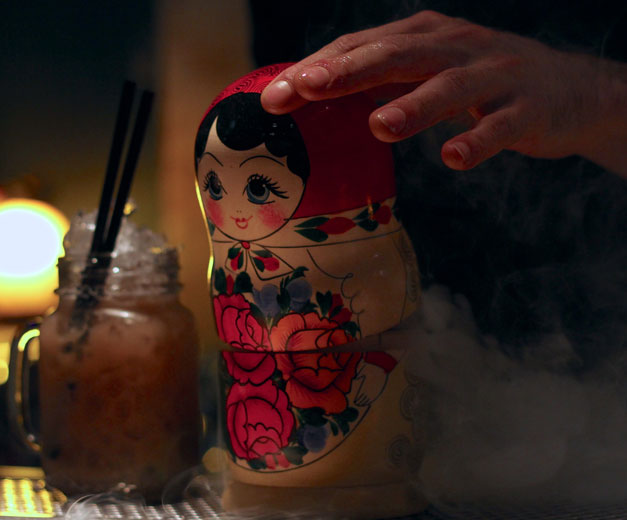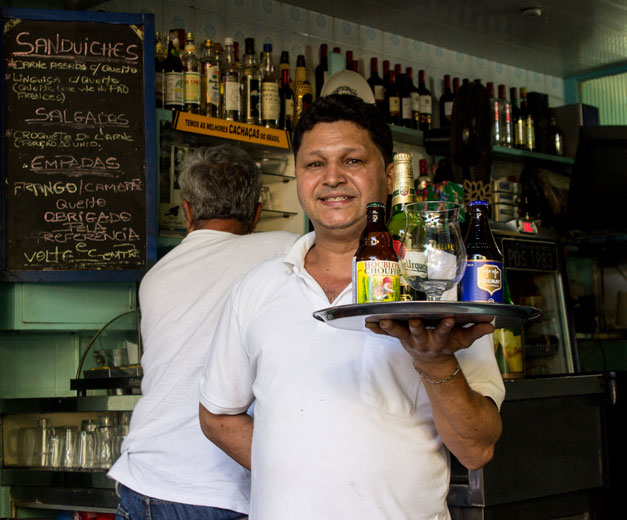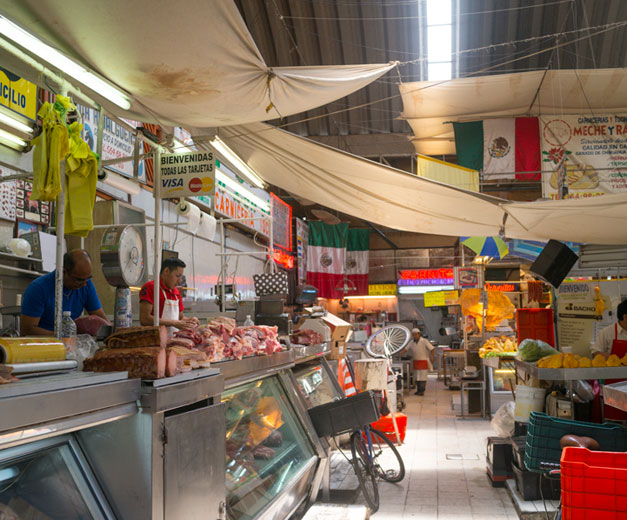We can't find the internet
Attempting to reconnect
Something went wrong!
Hang in there while we get back on track
Search results for "albert"
Rio
Confeitaria Colombo: Pastries over Bikinis
For a city whose natural beauty is what often sweeps visitors off their feet, Rio’s historical gems often look a little like urban ugly ducklings next to the bikini crowds and chic bars on sandy Ipanema beach. That’s a shame, because Rio Antigo has a great story to tell. Old Rio runs along the Guanabara Bay rather than the open Atlantic, and it was the former that gave the city its name – River of January – when Portuguese explorers came upon it in the first month of 1502.
Read moreRio
Rio de Janeiro: State of the Stomach
A grill of sizzling coração de galinha (chicken hearts), linguiça (sausage) and churrasco (steak) exudes a plume of smoke that sets the perfect theatrical stage as a woman in a red apron swings from side to side, dancing to Brazilian funk. The meat smells delicious, too. Maybe just one espetinho (skewer) before we go… Sundays at Feira da Glória market in Rio de Janeiro are an all-out assault on the senses – and on shoppers’ willpower. The sight of fruit stacked high on tables is almost as vibrant as Rio itself.
Read moreMexico City
Fogones Mx: 32 States, 32 Chefs
It’s not every day that a meal is as delicious as it is revelatory. Yet Fogones Mx, located in Mexico City’s Roma Norte, manages to serve this kind of experience every weekend. Sprung from the Centro Nacional de Investigación y Difusión de la Cocina Tradicional Mexicana (CENAIN) project (the National Center for the Research and Dissemination of Traditional Mexican Cuisine), Fogones is the result of a partnership between Sulema Vega and Luis Alberto Llanos, whose passion for traditional Mexican cooking inspired them to travel across the country’s 32 states in search for those flavors, recipes, techniques, and traditions that make up the foundations of Mexico’s rich and complex culinary landscape. "The original idea for CENAIN was born in Cabo San Lucas as a festival with 32 traditional cooks,” says Sulema. After a few bumps in the road, Luis Alberto, who remained at the head of the project, decided to embark on an epic trip across the country, and Sulema joined as a partner along the way.
Read morePorto
Best Bites 2024: Porto
The award for “Europe's Best Emerging Culinary City Destination," granted to Porto by the World Culinary Awards this year, could not have come at a better time. The city is truly "emerging" as a gastronomic hotspot, with an increasingly diverse array of restaurants and concepts opening their doors in response to growing tourism and a steady influx of new residents. Porto has never felt more dynamic. The latest wave of local projects further underscores this evolution. Chefs, baristas, sommeliers, and other culinary professionals from various nationalities have chosen Portugal's second-largest city to lay down roots, enriching its food scene and adding new dimensions to a city that still has much more to reveal.
Read moreMexico City
Best Bites 2024: Mexico City
It’s that time of year: when we share our Spotify Wrapped, post our favorite memories of the year on Instagram and, of course, reminisce about the incredible things we ate and drank over the past 12 months. Living (and eating) in Mexico City means there’s plenty to be grateful for – from revitalizing seafood cocktails to fluffy pancakes to, of course, fabulous tacos. Join us as we remember our Best Bites of 2024. It’s that time of year: when we share our Spotify Wrapped, post our favorite memories of the year on Instagram and, of course, reminisce about the incredible things we ate and drank over the past 12 months. Living (and eating) in Mexico City means there’s plenty to be grateful for – from revitalizing seafood cocktails to fluffy pancakes to, of course, fabulous tacos. Join us as we remember our Best Bites of 2024.
Read moreLos Angeles
Eastside Italian Deli: A Century of Sandwiches
In a relatively young city like Los Angeles, not many places have been open for more than 90 years, and even fewer have been open that long while staying relatively under the radar. Eastside Italian Deli is a delicious exception, having been around in the neighborhood that is now known as Victor Heights since 1929 (though it originally opened as Eastside Market). A small neighborhood between Chinatown and Echo Park, Victor Heights is often called the “Forgotten Edge,” but it was once home to a community of Italian immigrants who shopped at places like Eastside Market on a regular basis. These days, Eastside Italian Deli gets a steady stream of diners on weekday afternoons, from blue collar workers to high school students on summer break.
Read moreLisbon
Vida de Tasca: Keeping it Classic
It’s that quiet time between lunch and dinner, and we’re sitting with chef Leonor Godinho in a tasca, or rustic, casual, Portuguese restaurant. The furniture is sturdy but unremarkable, and walls are mostly bare except for a couple old photos, a child’s drawing and the ubiquitous vitrine, a built-in refrigerator. “I knew about this place because my best friends had just moved their studio to this building,” Leonor tells us of the space, formerly known as Casa do Alberto. “I would come here all the time to eat with them, and they would joke with me, ‘It would be great if this was yours!’”
Read moreMarseille
Neighborhoods to Visit: Marseille’s Les Goudes and L’Estaque
Marseille resembles an amphitheater – fitting for a city founded by the ancient Greeks. Encircled by the limestone cliffs of Calanques National Park, the green Garlaban hills and the mountainous Massif de l’Étoile, the port city is open wide to the Mediterranean with its back to the rest of France. This topography makes the city less French, more global, and intrinsically linked to the sea. Profoundly shaped by the goods, people, and cultures that have washed up on its shores for over 2,600 years, the Mare Nostrum has always taken center stage in Marseille. Two villages captain each end of the city’s 26 kilometer, semi-circular coastline. Though both fishing villages evoke yesteryear charm, they differ in look and feel. The northern quartier of L’Estaque retains the working-class ethos of its industrial past and is famous for snack shacks selling fried delights.
Read moreNaples
Best Bites 2023: Naples
In 2023 Naples boomed with tourism once again – every corner of the city was crowded with people. This post-Covid explosion of tourism runs the risk of distorting this historical city: an abnormal increase in vacation rentals and B&Bs has expelled many Neapolitans from the Historic Center, threatening the local market for traditional activities, goods and services. The city administration is taking action by limiting permits for new holiday homes and even pizzerias. We took advantage of this year to search out special places old and new, taking time to venture off the beaten track and finding solace in small corners of peace and gastronomic pleasure that only Naples can provide.
Read moreQueens
John’s Pizzeria: A Slice of Nostalgia
The eye-catching vintage sign proclaims: “ohn’s Pizzeria.” The letters in “Pizzeria” are in the bold carnivalesque font that decorates many decades-old slice joints in New York. As for “ohn’s,” it’s missing a one-of-a-kind flourishing cursive capital letter. “The J fell off,” says Susan Bagali, while ladling sauce onto a Sicilian pie behind the counter. “I called three companies and none of them could fix it right. I don’t wanna change it at all.” John’s Pizzeria’s unchanged appearance is exactly what first caught our eye while the corner restaurant was shuttered during the entire Covid-19 pandemic – for good, we worried.
Read moreBarcelona
Best Bites 2022: Barcelona
After two quiet years in Barcelona’s culinary scene due to the pandemic, it felt like in 2022 a storm of energy was released to shake up the city. On the more mainstream side, we saw bright re-launchings such as Teatro, a reincarnation (with new owners) of the Adriá-Iglesias brothers’ famous Tickets, and the resurrection of Albert Adrià’s Enigma after being closed for 27 months. There was also lots of movement in smaller neighborhood kitchens as local chefs fought heroically to adapt and survive, resulting in creative new partnerships like that of Bodega d’en Rafel and Celler Florida, or the forthcoming project at Mercat de la Llibertat from Alexis Peñalber of La Pubilla.
Read moreBarcelona
Pure Magic: Catalonia’s Mushroom Season
Mushroom hunting has an irresistible, magical pull. Composer John Cage, an avid mushroom collector, found them an integral part of his creative process, once writing: “Much can be learned about music by devoting oneself to the mushroom.” Every fall, thousands of Catalans likewise find themselves under the mushroom’s spell, following the elusive fungus’s silent melody into the woods, a rustic wicker basket in one hand and – more and more these days – a GPS-enabled smartphone in the other. This practice is an old tradition in Catalonia that begins in the forest and ends at the dinner table. Nowadays, the tradition has become a hugely popular pastime for aficionados, called boletaires in Catalan.
Read moreBarcelona
Bodega Salvat: Under Old Management
At Bodega Salvat in the Sants neighborhood, large wooden wine barrels perched on high shelves almost touch the ceiling, looking down on those drinking below with more than 100 years of local history. For several generations of Sants residents, this old bodega, opened in 1880 by the Salvat Vidal family as a bulk wine store, is a fixture of daily life. Now, after a few decades of being run by others, Bodega Salvat’s original owners have returned to bring a new shine to their family gem. The Salvat Vidals, who still own the building housing the more-than-100-year-old watering hole, now protected by the Barcelona City Council as an “iconic bodega,” have passed the business on to various owners over the years.
Read moreBarcelona
Bodega La Palma: Gothic Pillar
Although the Gothic neighborhood in Barcelona’s Ciutat Vella (“Old City”) district is supported by deep foundations – it’s the site of the former Roman village of Barcino – much of the quarter’s more recent history has been swept away by the rise of tourism. The few remaining old shops and businesses are often in a precarious position, exposed to the changing times, and yet they continue to stand strong. One such spot is Bodega La Palma, which dates back to at least 1909. Back then it was a shop that sold a little bit of everything as well as bulk wine; now it’s a tapas bar, one that serves as a multigenerational meeting point for locals and visitors (when they’re around).
Read moreBarcelona
Cooking for Good: Solidarity Kitchens in Barcelona
You never think that it’s going to be you. But one day, everything goes topsy-turvy, and suddenly you find yourself doing the unimaginable: searching for information on how to access donated food or meals. Thousands of individuals and families in Spain have found themselves in this difficult position during the Covid-19 pandemic. City councils in Catalonia have seen double the normal number of petitions for assistance in the last month or two, while that figure has tripled for Cáritas, the large Catholic charity in Spain. And the Creu Roja (Catalan Red Cross) has received around 10,000 new petitions per week since Spain’s state of alarm began, over 60,000 in total.
Read moreMexico City
Caldos de Gallina Don Beto: A Mexico City Market Vendor Confronts the Crisis
Enrique Del Moral (1905-1987) was one of the most important architects of modern Mexico. Together with Mario Pani and Pedro Ramírez Vázquez, he revamped Mexico City in the 1950s. One of his most important designs was the new La Merced Market, which opened in 1957 (the market built in the 1860s was demolished to make way for the new structures). Located east of Mexico City’s Main Square, the massive market used to be the wholesaler for the city, until La Central de Abasto was built in the late 20th century. Today, I want to talk about a family who has been working for 38 years inside Nave Mayor, by far the biggest of the original seven market spaces in Enrique Del Moral’s design.
Read moreMarseille
Ahwash: The Berber of Marseille
Once the stomping ground of sailors and the Corsican mafia, Marseille’s oldest district, Le Panier, has evolved into a tourist hub and creative neighborhood. Its winding streets are peppered with ateliers (like blade smiths, chocolatiers and painters) and the 17th-century facades are canvases for colorful murals. One of them, a powerful black-and-white image of a couple kissing, faces the funky cantine and concept store, Ahwash. Its owner, Amar, commissioned the Alberto Ruce work – a sign of the artistic energy infused throughout his unique place. Named for the traditional Berber dance in which men and women mix together, Ahwash is a blend of Amar’s worlds – of Morocco and France, of art and cooking. “Eating here is like coming to my house,” he smiles, serving tagines to patrons sitting at vintage tables topped with glowing candles, their dripping wax embodying the restaurant’s romantic and relaxed ambiance.
Read moreLisbon
Tasca Tables: Deeply Local at Adega da Bairrada
Despite being one of the liveliest of Lisbon’s neighborhoods, Alvalade doesn’t appear in most city guides. Maybe because of the location, north of downtown and next to the airport, with planes taking off and landing being part of the usual sights and sounds. Maybe because it is mainly a residential area, with few – if any – hotels available nearby. Maybe because it is seen as a strictly local neighborhood, with no museums, elevated viewpoints or places to listen to fado. But despite all that, it has a lot to offer, especially to those who want to eat, shop or simply roam the streets with the locals.
Read moreElsewhere
Going Deep: Neighborhoods to Visit in 2020
As the calendar year turns over, we’ve grown accustomed to the barrage of lists telling us where to travel during the next 12 months. Often these places are a country or even a whole region – you could spend an entire year exploring just one of the locations listed and still barely make a dent. We like to travel on a smaller scale. Forget countries and cities, for us the neighborhood is the ideal unit of exploration. Celebrating neighborhood life and businesses is, of course, essential to what we do as Culinary Backstreets. Since our founding in 2012, we’ve been dedicated to publishing the stories of unsung local culinary heroes and visiting them on our food walks, particularly in neighborhoods that are off the beaten path.
Read moreNaples
Cantina del Gallo: Rosario’s Hideaway
We’ve got a thing for small, family-run spots in Naples, particularly those that are multigenerational. If a restaurant or bakery or producer has been open for at least a century and has always stubbornly stood in the same place, continuity and quality of product are all but guaranteed. Take, for instance, Cantina del Gallo in Materdei. Established in 1898 and run by four generations of the Silvestri family, this is one of the few real outdoor taverns left in Naples. Over the years, this cozy, simple spot has attracted artists, intellectuals, musicians, travelers and many Neapolitan students looking for good food at reasonable prices.
Read moreNaples
Mimì alla Ferrovia: Innovation at a Temple of Tradition
On a recent visit to the market of Sant’Antonio Abate, a pilgrimage site for fresh produce, we made friends with Salvatore, a young Neapolitan chef who was buying fruit and vegetables for his restaurant. We thought nothing of it until we bumped into him again, this time when he was buying fresh bluefish, the symbol and pride, he told us, of his restaurant. Our curiosity piqued, we asked where he worked. Mimì alla Ferrovia, he told us, a name we immediately recognized – it’s one of the custodians of Neapolitan gastronomic orthodoxy. And Salvatore Giugliano, an innovative young chef of 27, is now at the helm of this historic restaurant.
Read moreBarcelona
Barcelona: State of the Stomach
In 1977, just two years after the death of Franco, the great Catalan gourmet Manuel Vázquez Montalbán published a book titled L’art de manjar en Catalunya (The Art of Eating in Catalonia). The book, as well as the prologue written by Montalbán’s mentor Néstor Luján, rang the alarm bells, claiming that authentic Catalan cuisine was in grave danger and on the brink of disappearance. As Montalbán saw it, the unique Catalan culinary identity has been reduced to a few ubiquitous dishes: pan a la Catalan (bread with tomato pulp and ham) and rabbit with aioli. This demise was due, in his opinion, to the frenzied pace of modern life, the lack of high-quality ingredients, the ignorance of both restaurateurs and tourists regarding what good cuisine, not to mention true Catalan cooking, looks and tastes like and, of course, the Franco regime’s efforts at suppressing regional identities.
Read moreBarcelona
Best Bites 2017: Barcelona
This was an intense year for Barcelona, with a complex political situation stemming from Catalonia’s bid for independence from Spain. It was a storm that the culinary scene could not help but get caught up in. Bars and restaurants have always been a temple of leisure and pleasure, but we sometimes forget that they also serve as a space for people to connect and debate. And in the spirit of debate, food and drink constitute another form of expression, an indication of a restaurant’s cultural leanings. In Barcelona this year, we could taste the continued interest in developing and strengthening Catalan cuisine, often considered an extension of Catalan identity. But we also observed the food scene’s openness to other regional cultures and global influences.
Read moreBarcelona
Bodega Bartolí: Built on Soup
Bodega Bartolí opened in 1939 as a little bulk wine shop in Barcelona’s Sants neighborhood. Then everything changed for the bodega some 20 years later when a local client arrived with a stomachache. He asked a young Marina Dolz, who was minding the wine shop with her husband, if she could prepare some soup for him. It was the first dish she cooked there and, since then, Bodega Bartolí has moved far beyond simply being a wine store. At the time Bodega Bartolí opened, Sants was still an industrial quarter with several factories and thousands of workers. During the 1940s, the bodega sold both bulk wine to the neighbors and factory employees and barreja (a very traditional drink made of Muscat wine and anise liquor) to the wheelwrights passed by everyday.
Read moreBarcelona
Bubbling Over: Barcelona Braces for the Catalan Independence Referendum
Bar chats are on fire these days in Barcelona. As the controversial Catalan independence referendum draws closer, it’s not uncommon to witness spontaneous private discussions or overhear customers express passionate or indignant comments while reading the newspaper or watching the news on the bar’s TV. There is tension in the air, and bars, perennially popular agoras for debate, have become even livelier places. Many Catalans, whether pro-independence or not, will find themselves voting under difficult conditions on Sunday, October 1, in the controversial referendum organized by the Catalan government.
Read moreMexico City
La Secina: Beef & Blues
One feels cooler simply for patronizing La Secina. The architecture of the restaurant seems to evoke a perpetual party vibe. At dinner, individual lights dangle on long lines amid a mesh of vines that gives the cavernous space a homey, DIY feel. The teal and orange on the wall are bright and clean. The stenciled restaurant logo and exhortations of “bienvenidos” feel as organic as they do well designed. Downstairs, picnic tables radiate outwards from a long, inviting bar. Upstairs a dedicated booze closet services a patio that looks out upon a beautiful church across the street. And on weekends, live blues bands play everything from Albert Collins to Muddy Waters to Robert Johnson.
Read moreBarcelona
Gelida: Old Faithful
At the beginning, Gelida was just a bodega where Joan Llopart i Figueres, who came from the village of Gelida in Penedés, offered Catalan wine, cold cuts and a few traditional Catalan dishes cooked by his grandmother, like butifarra amb mongetas (boiled sausage with beans). Llopart i Figueres and his wife worked here until they were in their 80s. They were succeeded by their two children, Teresa and Alberto, who have always been involved in the family business and who continue to run the place today alongside their respective spouses, Josep and Luci. Alberto and Luci’s son, Gerard, helps to manage the restaurant, and Laura and Santi, family friends who live nearby, joined the team in recent years as dining room manager and chef.
Read moreLisbon
Poema do Semba: The Musical Kitchen
Behind a discreet entrance on one of Lisbon’s principal avenues, a sophisticated environment with a minimal interior houses a loyal Luanda-Lisboa jetset crowd who is here for the great food – and great music. Poemas do Semba, its walls decorated with black-and-white photographs, is an unlikely find in this neighborhood. Santos is the former stomping ground of the Portuguese nobility; today some of their former palaces have been turned into embassies or luxury hotels. Students and a design-y crowd have taken over as well, thanks to the nearby college. This exclusive African restaurant was opened in 2014 by the famous Angolan singer Paulo Flores, a semba exemplar who has numerous albums to his name.
Read moreBarcelona
Butifarring: Tubular Gastronomy
[Editor's note: we're sorry to report that Butifarring is now closed.] Gourmet fast food has swept through Spain at full speed. It comes in multiregional styles and with strong creative inspiration behind it – and, most importantly, the food itself can be exceptional.Eric Camp, Albert Gómez and their three partners are a good example of this, with their sausage-centric project, Butifarring, and their first small venue in Barrio Gòtico, which is much more than a Catalan hot dog or sandwich place.
Read moreBarcelona
Barcelona's Gintonics: Good to the Last Drop
Editor's note: Our third installment in the Global Bar Crawl takes us to Barcelona, where gin continues to be the drink of choice among locals. Tomorrow we head to a spot in Istanbul where you can spend an evening visiting a number of bars, all without leaving the building. Spain is a country that loves a long-drink – alcohol in combination with a soft drink, refreshing and open to invention and reinvention. On the heels of creative gastronomy’s efflorescence in recent years, many old drinks, cuisines and forgotten ingredients have returned, revived through new and more sophisticated techniques and interpretations. The gin and tonic, called gintonic here, is one such Spanish obsession, and all that ingenuity and focus have gone into taking this highball to the next level.
Read moreBarcelona
El Tossal: Down from the Mountains
Now that ski season has begun in Catalonia, thousands of Barcelonans make the pilgrimage every weekend to the Pyrenees. But winter sports are not the only draw; this is also the time to enjoy the cooking at masias, traditional farm buildings that have been converted into restaurants.There, the smells of winter stews and dishes made with mushrooms, game, mongetes (beans) and butifarra (a kind of pork sausage) are motivation enough to arrive at the village early and in one piece.
Read more




















